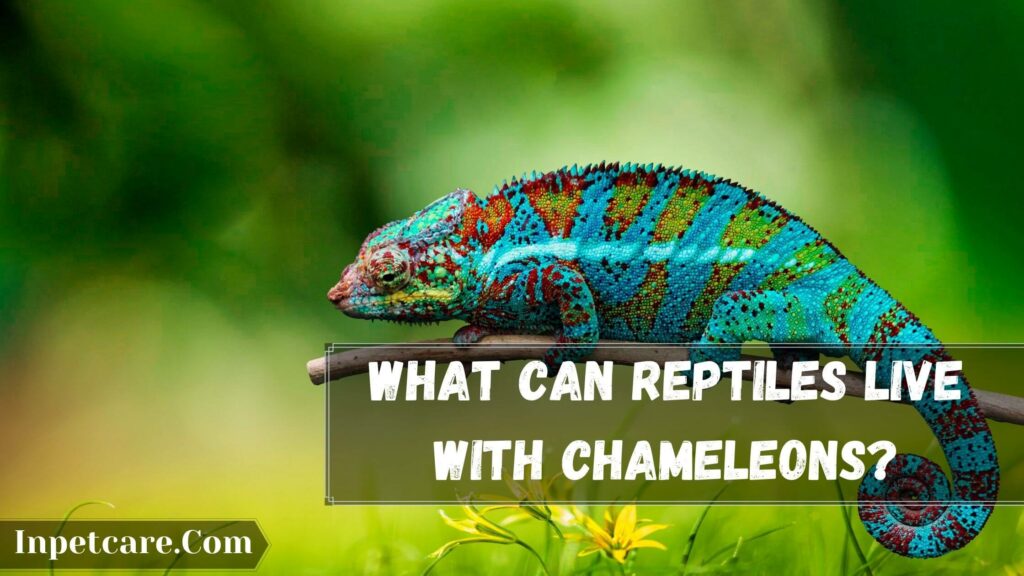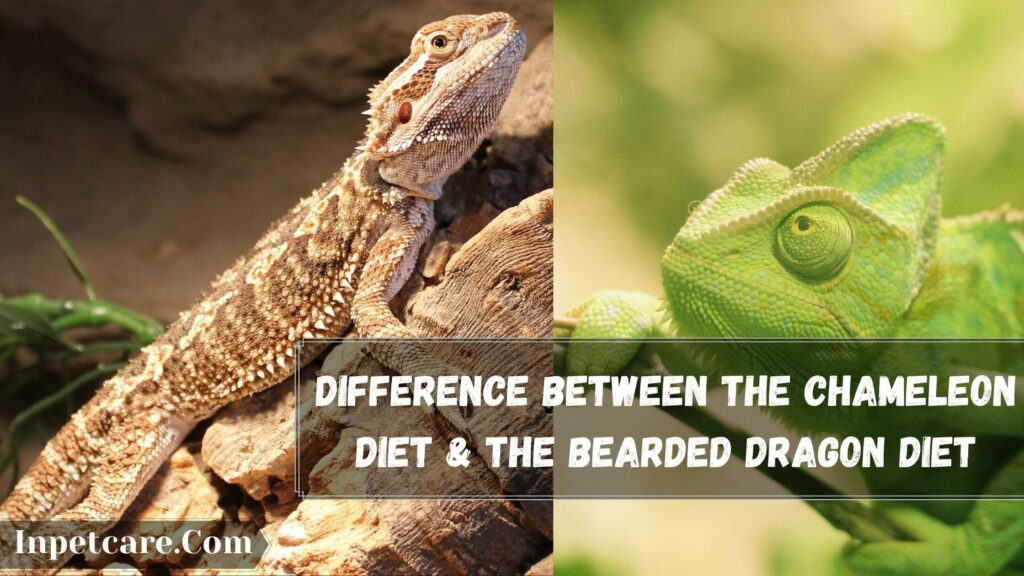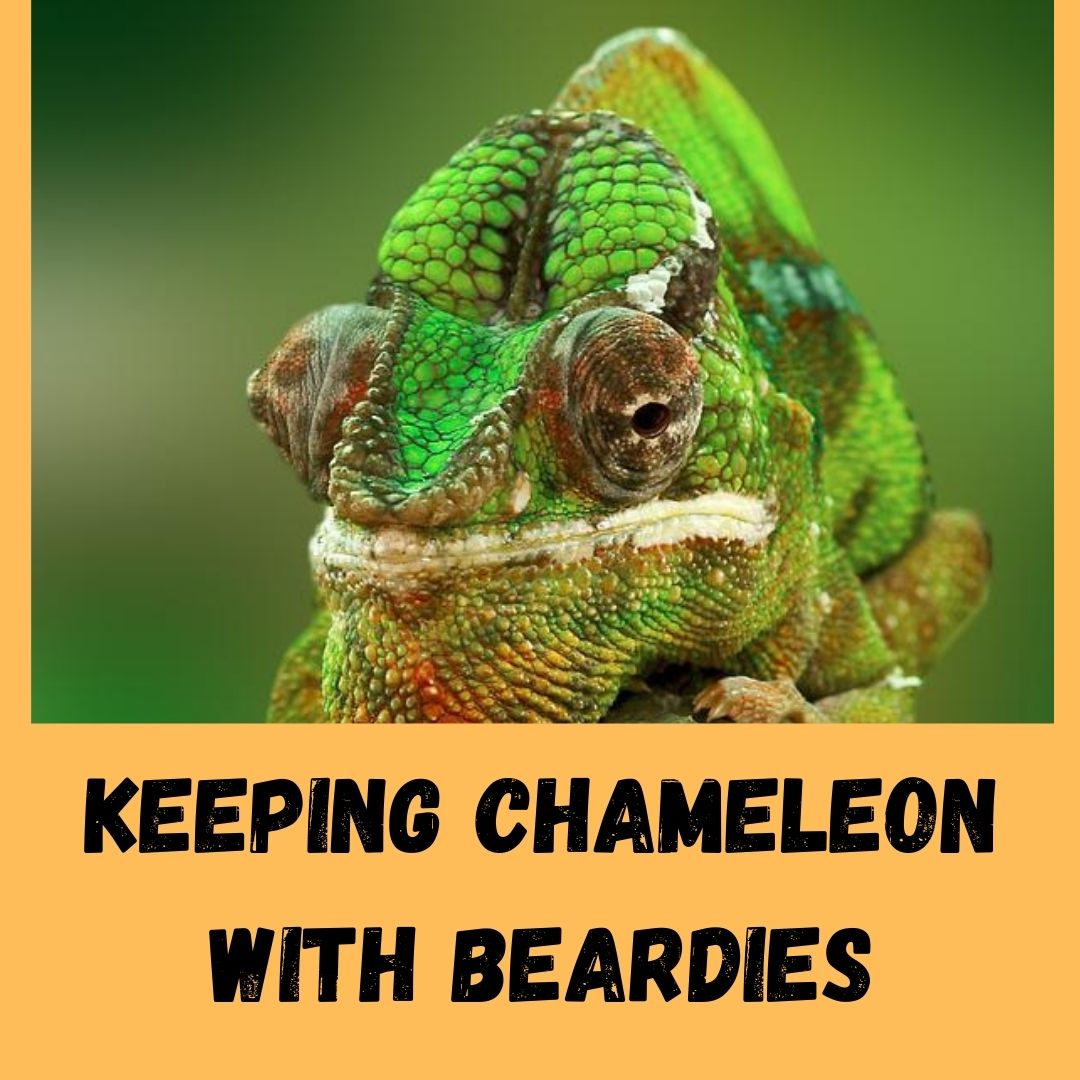If you think of adding another reptile to an existing enclosure with your bearded dragon, you might wonder if they can get along. In this article, we will explore the compatibility between two popular species of reptiles.
We’ll even talk about the differences in their Habitat, diet, and behavior to see if a bearded dragon and chameleon can make good companions. Therefore let’s first know: can a chameleon live in a bearded dragon tank.
Can A Chameleon Live In A Bearded Dragon Tank?
No. Chameleons can never live with the bearded dragon in the same Habitat as it can lead to conflict. Both the species have different Habitat needs, diets, and behavior, making them vulnerable to conflict.
Even if you have a large enclosure with plenty of items and branches for both the species to thrive and hide when they need to retreat, it is tough to make them able to coexist together in the same tank.
Some might have succeeded in keeping both the species together in a large enough enclosure with plenty of items for both the species, but monitoring them closely is needed to ensure there is no conflict between them.
What Reptiles Can Live With Chameleons?

It is important to do your proper research before bringing any new reptile friend to your home like any other pet animal. It is important to check whether the pet you are getting is compatible with your existing Reptile or not. It would help if you also did proper research to be prepared to care for them properly. Therefore here, we will know what reptiles get from chameleons.
Talking about other reptiles, most don’t do well with other species. The same goes for chameleons also. Chameleons also don’t do very well with other reptiles as they are said to be solitary creatures by Nature who prefer living alone due to being shy and secretive.
Adding to this, chameleons can be territorial and may even attack other reptiles if they feel threatened. It is better never to house another Reptile with chameleons to avoid any potential complaints. There are a few exceptions to every rule.
When we talk of a few species of reptiles that can live with chameleons, only some species of geckos can get along sometimes but not bearded dragons. Bearded dragons are generally considered the most popular exotic pet reptile in today’s world.
If you decide to add a few baby bearded dragons with your adult Chameleons, there are huge chances for these small reptiles being eaten by your Chameleons. Always adopt another species of Chameleons rather than going with another Reptile species like bearded Dragons. Therefore, chameleons can be temperamental and difficult to care for, so it may be best to leave them alone.
What Animals Can Be Kept With Bearded Dragons?
Bearded dragons can coexist with certain reptiles and lizards When everything is set up properly in the tank. Anoles, turtles, and tortoises can live successfully together with bearded dragons in the same tank if all care equally.
Conflict can arise because a bearded dragon tends to be territorial. You should avoid keeping them combined in one tank, even if they are of the same species. You should avoid keeping two male reptiles in the same cage; otherwise, territorial conflict and dominant behavior will occur.
What Reptiles Do Not Get Along With Bearded Dragons And Chameleons?
Many reptiles don’t get along with chameleons and bearded dragons, which should be avoided. Reptiles like iguanas, snakes, and turtles should never be kept with chameleons or Dragons. If you already have one of these, it is best to keep them in a separate cage to avoid any potential conflict or injury.
Both the species are highly territorial creatures and can get aggressive if they feel their space is being attacked. In a threatening situation, both tend to be violent. If another reptile gets too close to their area, both are likely to lash out with their claws and powerful jaws. Speaking of bearded dragons, they can cause serious injuries to other animals.
If you are getting a new reptile, do your research on what snakes or lizards make good tank mates with chameleons or bearded dragons. Bearded dragons are a good companion for chameleons if housed in an extremely large cage with all the equipment.
In most cases, it is impossible to get a tank of 150-180 gallons for both species to be housed together. Therefore it is always best to accommodate each reptile species in its separate tank with suitable conditions and equipment for a happy and healthy life.
Differentiality among Chameleons and Geckos
Bearded dragons and Chameleons are different types of reptiles belonging to other families. Both of its families have hundreds of species. Bearded dragons hail from the desert -areas, whereas chameleons come from Europe, Africa, and Asia.
With that said, bearded dragons love basking in the sunlight, whereas chameleons prefer climbing on trees. Chameleons are seen resting in the tree branches in the wild, whereas bearded dragons lay on the ground.
Adding to this, both the species have some varieties. Dragons need more Greens as they grow up, and chameleons feed on insects mostly. Talking about their behavior, bearded dragons are considered outgoing and active, whereas chameleons are shy and secretive.
Both the behavior makes them vulnerable to conflict. Chameleons also tend to change their colors to blend with their surroundings, whereas bearded dragons use their body movements to communicate with others, including what they are feeling. Plus, bearded dragon brumate, which Chameleons don’t. Let’s talk about what reptiles can leave with family chameleons.
Difference Between The Chameleon Diet & The Bearded Dragon Diet

The Chameleon diet usually includes insects, whereas the bearded dragon diet consists of fruits, leafy greens, vegetables, and some invertebrates. Adding to this, a Chameleon also eats more often than a dragon. Bearded dragons are known to go without food for many days, whereas chameleons need food every day or two.
Here you’ll learn how long a bearded dragon can go without food. Both the species are diurnal, meaning they are active during the day and sleep at night. Chameleons come out during the day to hunt insects, whereas bearded dragons usually come out to forage on plant matters.
Bearded dragons tend to be insectivorous only when they are hatchling and juvenile, but they gradually shift to a herbivorous diet as they grow up.
On the other hand, chameleons need an insectivorous diet mostly. Feeding both the species can be fairly easy because both have almost the same diet, except for the number of insects.
You need to limit the number of insects in your bearded dragon diet while providing more to your Chameleon serving. It is always important to research the reptiles’ dietary needs before bringing one home.
Differences Between Chameleon Habitats & The Bearded Dragon Habitats
The most familiar difference between both reptiles is the preferred Habitat. Both rely on the external light source for regulating their body temperature, but both have different preferences in terms of equipment and items placed in their Habitat.
Chameleons usually love to climb as they are arboreal, and you will need lots of climbing obstacles and high tank. It would help if you also had an enclose high enough for them to climb and thrive. On the other hand, a bearded dragon needs a wide enclosure.
Both species need food bowls, water dishes, bedding, and hidings, but the temperature required for that Habitat differs. Another difference is that chameleons are usually carnivorous or insectivorous, whereas bearded dragons are omnivorous.
Therefore, it also means that keeping them in the same Habitat will make it difficult for you to feed both the reptiles different food to ensure they are getting all the nutrients they need to maintain their proper body function daily.
As the humidity and the temperature requirement is completely different for both, it can be tough for you to hold it in the same Habitat. It is almost impossible to regulate the body temperature for both species if kept in the same tank.
For instance, chameleons need higher humidity and temperature levels to maintain their body function and stay active compared to bearded dragons. As Both are ectothermic, both will need external sources of heat and lightning to regulate the body temperature.
If your concern is to keep both the species in the same tank, then make sure to avoid it because their habitats need different settings that meet their specific requirement. Keeping both in the same Habitat may injure or kill one of your reptiles.
Difference Between Chameleons & Bearded Dragon Behaviour
Both species are the two most popular exotic pet reptiles that have been adopted by many people recently. They are popular because of their unique personality and behavior. With varying preferences, they also have some differences in behavior.
Bearded dragons are known to bask in direct sunlight than chameleons, who like to climb and explore their surroundings. In addition, chameleons also change their color in response to their surroundings, whereas bearded dragons are bound to their gestures and body movements.
Both have compatibility issues when housed together. Adding to this, bearded dragons are less territorial compared to chameleons. A bearded dragon may scare off your chameleon with its head bobbing and puffing up, resulting in a stressful situation.
Slow-moving Chameleons can also get injured by bearded dragons if they feel their space is being threatened. Even if champions are more territorial, a bearded dragon is likely to attack first.
Conclusion
These differences in diet, behavior, and Habitat make them unsuitable for keeping in the same tank. You can keep these reptiles, chameleons, and bearded dragons in the same home or room but not in the same tank. You learned that Chameleons are carnivorous or insectivorous, whereas bearded dragons are omnivorous.
Adding to this, Chameleons also need a higher humidity and temperature level compared to the bearded dragon for keeping in the same tank. I have tried my best to enlighten you with all the information that can help you learn whether they’re suitable to coexist together.
If you find this article helpful, share it with others. We have shared many other guides on what reptiles can live with each other for you to check out. Do check out another article on bearded dragon care and health. See you in another article, till then take care and goodbye.

94% of pet owners say their animal pal makes them smile more than once a day. In 2007, I realized that I was made for saving Animals. My father is a Vet, and I think every pet deserves one. I started this blog, “InPetCare”, in 2019 with my father to enlighten a wider audience.

